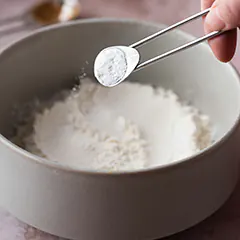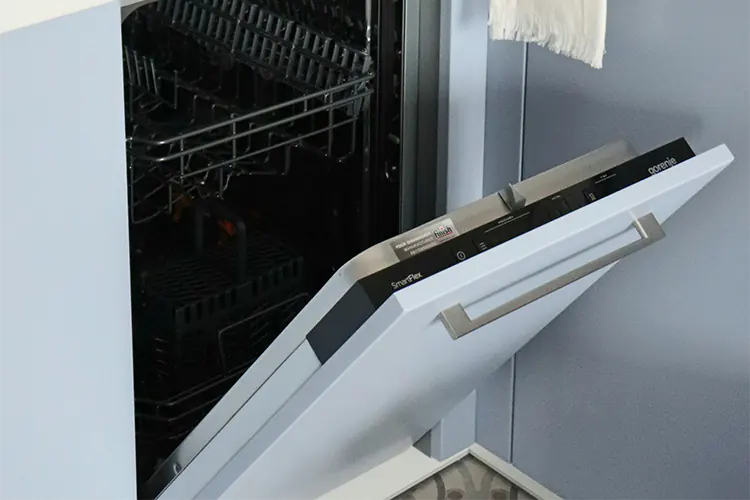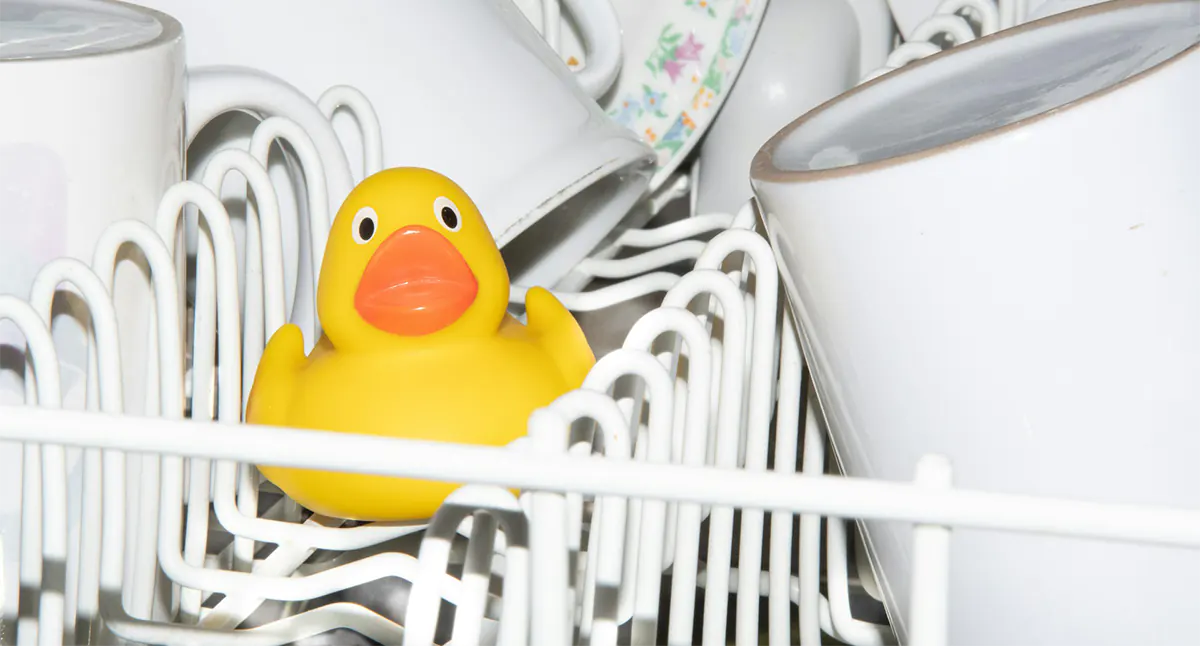As a DIY specialist who has helped countless homeowners restore their appliances, I understand the frustration when your dishwasher stops performing at its best.
Over my years of hands-on experience, I've discovered that a well-maintained dishwasher not only cleans dishes more effectively but also lasts significantly longer and saves you money on costly repairs.
Practical chapters
- Deep cleaning with vinegar and baking soda
- Vinegar and baking soda — FAQ
- Filter cleaning and maintenance
- Filter cleaning — FAQ
- Spray arm cleaning and unclogging
- Spray arm cleaning — FAQ
- Commercial dishwasher cleaners
- Alternative commercial cleaning methods
- Commercial cleaners — FAQ
- Dishwasher exterior and door cleaning
- Exterior cleaning: stainless steel
- Door and seal cleaning
- Dishwasher exterior cleaning — FAQ
- Odor elimination and sanitization
- Natural odor elimination methods
- Sanitization techniques
- Odor removal and sanitization — FAQ
- Maintenance schedule and prevention
Your dishwasher works tirelessly to clean your dishes, but over time, food particles, grease, soap scum, and mineral deposits accumulate inside the machine.
This buildup affects water circulation, reduces cleaning power, and can create unpleasant odors.
The good news? I'll guide you through every proven method to deep clean your dishwasher using both natural DIY solutions and effective cleaning products.
Whether you're dealing with stubborn limescale, clogged spray arms, or mysterious odors, this comprehensive guide covers all the solutions you need to restore your dishwasher to like-new condition.
Introduction to Natural Cleaning Methods
This is my go-to method for monthly deep cleaning because it's affordable, effective, and uses ingredients you likely already have at home.
The acidic properties of vinegar dissolve mineral deposits and soap scum, while baking soda neutralizes odors and provides gentle abrasive action.
Dishwasher Deep Cleaning with Vinegar and Baking Soda


Step-by-Step Vinegar Deep Clean
- Preparation
Remove all dishes, utensils, and racks from your dishwasher.
Clear any visible food debris from the bottom of the tub. - Clean removable parts
Remove the bottom rack and utensil holders. If they're heavily soiled, soak them in your sink with warm water and two cups of white vinegar for 20 minutes. - Check and clean the filter
Remove the filter (typically found at the bottom center) and rinse under warm water. Use a soft brush to remove stubborn debris. - Vinegar cycle
Place 2 cups of white distilled vinegar in a dishwasher-safe glass container on the top rack. Run a complete hot cycle without detergent, but turn off the heated dry option. - Baking soda cycle
After the vinegar cycle completes, sprinkle 1 cup of baking soda across the bottom of the tub. Run a short hot cycle. - Final steps
Open the door and let the dishwasher air dry completely.
Receive the best offers for your home, negotiated for you
Unsubscribe anytime. We promise, no misused or sold emails, we hate unsolicited mailings.Q: Can I use apple cider vinegar instead of white vinegar?
A: While possible, I recommend white distilled vinegar because it doesn't contain coloring agents that could stain your dishwasher interior.
Q: Can I use vinegar and baking soda together?
A: No, never use them simultaneously as they neutralize each other. Always run separate cycles.
Q: How often should I perform this deep clean?
A: I recommend monthly for most households, or every 2-3 weeks if you use your dishwasher daily or have hard water.
Q: Is this method safe for stainless steel interiors?
A: Yes, but don't use vinegar too frequently as the acid can potentially damage the finish over time if overused.
Dishwasher Filter Cleaning and Maintenance
Understanding Your Dishwasher Filter
The filter is your dishwasher's first line of defense against food particles and debris.
Most modern dishwashers have manual filters that require regular cleaning, while older models may have self-cleaning filters with grinders.

Complete Filter Cleaning Process
- Access the filter
Remove the bottom rack to expose the dishwasher floor.
The filter is typically located at the bottom center, around the base of the lower spray arm. - Remove the filter
Most filters have a cylindrical upper assembly that twists counterclockwise and lifts out. Some models also have a flat lower filter that simply lifts out. - Initial rinse
Rinse both filter components under warm running water to remove loose debris. - Deep cleaning
For stubborn buildup, soak the filters in warm soapy water for 15-30 minutes.
Use a soft-bristled brush or old toothbrush to gently scrub the mesh screen and plastic components. - Inspect and rinse
Check for any damage to the filter mesh. Rinse thoroughly until water runs clear. - Clean the filter housing
While the filter components dry, wipe down the filter housing area in the dishwasher with a damp microfiber cloth. - Reinstall
Ensure the lower filter sits flat, then insert the upper filter assembly and turn clockwise until it locks in place.
Q: How do I know if my dishwasher has a self-cleaning or manual filter?
A: Look at the bottom of your dishwasher. If you see a removable cylindrical component, you have a manual filter. If you see a plastic grid or series of holes, you likely have a self-cleaning filter.
Q: What if my filter seems damaged?
A: Replace it immediately. A damaged filter can't protect your dishwasher's pump and will reduce cleaning performance.
Q: Can I put the filter in the dishwasher to clean it?
A: No, always clean filters by hand to ensure thorough cleaning and prevent damage.
Q: Why does my filter get dirty so quickly?
A: Pre-scrape (don't pre-rinse) your dishes to remove large food particles, and ensure you're using quality dishwasher detergent.
Advanced Dishwasher Cleaning Technique: Spray Arm Cleaning and Unclogging
The Importance of Clean Spray Arms
Spray arms distribute water throughout your dishwasher.
When their holes become clogged with food particles or mineral deposits, water pressure drops dramatically, resulting in poor cleaning performance.
Comprehensive Spray Arm Cleaning
1. Remove the spray arms
- Lower arm:
Usually twists counterclockwise or lifts straight up - Upper arm:
May unscrew or unclip from the top rack - Middle arm:
Some dishwashers have a third arm that clips off
2. Initial inspection
Check each spray arm for visible blockages in the holes and examine for cracks or damage.
3. Soak treatment
Submerge spray arms in a solution of warm water and dish soap for 15-30 minutes.
For mineral deposits, use a vinegar solution instead.
4. Unclog the holes
Use these tools to clear blocked holes:
- Toothpicks for small debris
- Thin wire or straightened paperclip for stubborn clogs
- Pipe cleaners for thorough cleaning
- Small bottle brush for interior passages
5. Thorough rinse
Run water through each spray arm, shaking gently to dislodge loosened debris.
6. Test rotation
Before reinstalling, spin each arm by hand to ensure it rotates freely.
7. Reinstall securely
Make sure each spray arm is properly seated and locked in place.
Q: How often should I clean the spray arms?
A: Every 2-3 months, or immediately if you notice reduced cleaning performance.
Q: Can I prevent spray arm clogs?
A: Yes, scrape dishes before loading, use rinse aid, and run hot water at your kitchen sink before starting the dishwasher to ensure hot water enters immediately.
Q: What if a spray arm won't come off?
A: Consult your dishwasher manual for specific removal instructions, as methods vary by manufacturer and model.
Q: Can I replace spray arms if they're damaged?
A: Absolutely. Contact your dishwasher manufacturer or appliance parts supplier with your model number.
Commercial Dishwasher Cleaners
When to Use Commercial Cleaners
While natural methods are excellent for regular maintenance, commercial cleaners are formulated to tackle tough buildup, particularly in hard water areas or when dealing with heavy mineral deposits.
Using Dishwasher Cleaning Tablets
- Preparation
Remove all dishes and utensils from the dishwasher.
Clean the filter and remove any visible debris. - Tablet placement
— Empty dishwasher: Place one tablet in the main detergent compartment
— With dishes: Place one tablet on the bottom of the tub under the bottom rack - Run the cycle
Select a normal wash cycle with the hottest water setting.
Don't add regular detergent. - Post-cleaning wipe
After the cycle, wipe down any remaining residue with a soft cloth. - Multiple treatments
For severe buildup, you may need to repeat the process.
Alternative Commercial Cleaning Methods
- Liquid cleaners
Some brands offer liquid formulations that come in special bottles designed to dispense during the wash cycle. - Powder cleaners
Mix according to package directions and place in the detergent compartment. - Descaling products
Specifically formulated for hard water mineral removal.
Q: Are commercial cleaners safe for all dishwasher types?
A: Most are compatible with both stainless steel and plastic tub dishwashers, but always check the product label and your dishwasher manual.
Q: Can I use commercial cleaners with dishes in the dishwasher?
A: Some products allow this, but read the instructions carefully. When in doubt, run an empty cycle.
Q: How often should I use commercial cleaners?
A: Monthly for regular maintenance, or more frequently in hard water areas.
Q: Are commercial cleaners better than DIY methods?
A: Both have advantages. Commercial cleaners are convenient and formulated for specific problems, while DIY methods are economical and use readily available ingredients.
Dishwasher Exterior and Door Cleaning
Complete Exterior Cleaning
Your dishwasher's exterior requires different care depending on the finish type.
Stainless Steel Exterior Cleaning

- Basic cleaning
Use a soft microfiber cloth with warm soapy water, wiping in the direction of the grain. - Removing fingerprints
For stubborn fingerprints, use a mixture of equal parts white vinegar and olive oil on a microfiber cloth. - Polishing
Apply the olive oil sparingly and buff to a shine, always following the grain direction. - Commercial cleaners
Stainless steel cleaners provide excellent results and protective coatings. - Interior door
Wipe down with a damp microfiber cloth, paying attention to the bottom edge where debris collects. - Rubber door seals
Clean gently with an old soft toothbrush and a solution of warm water and mild dish soap. Check for mold or mildew in the crevices. - Control panel
Use a barely damp cloth to avoid water damage to electronic controls. - Handle cleaning
Clean thoroughly, as this high-touch area harbors bacteria. - Lemon method
Place fresh lemon slices or 1 cup of lemon juice in a dishwasher-safe container on the top rack and run a hot cycle. - Citrus cleaning
Cut citrus fruits (lemons, oranges, grapefruits) into quarters, remove seeds, and place throughout the dishwasher before running a cycle. - Vinegar deodorizing
The vinegar method described in Chapter 1 effectively eliminates most odors. - Built-in sanitize cycle
If your dishwasher has this feature, use it monthly. It heats water to at least 150°F to kill bacteria. - Bleach sanitization (non-stainless steel only!)
Place 1 cup of bleach in a dishwasher-safe bowl on the top rack and run a full hot cycle. Never use with stainless steel components. - High-temperature rinse
Run the hottest cycle available to sanitize through heat alone. - After each load
Remove any visible food debris from the bottom of the dishwasher. - Weekly
Wipe down door edges and seals; quick filter check and rinse if needed. - Monthly
Complete deep clean using vinegar and baking soda method OR commercial cleaner; thorough filter cleaning; spray arm inspection and cleaning. - Quarterly
Deep clean spray arms; check and clean door seals thoroughly; descale if you have hard water. - As needed
Clean exterior; address odors immediately; sanitize after washing heavily soiled items. - Proper loading
Don't overcrowd; ensure spray arms can rotate freely; face soiled surfaces toward spray arms. - Pre-treatment
Scrape (don't rinse) dishes to remove large food particles; rinse off sticky substances like honey or peanut butter. - Water temperature
Run hot water at your kitchen sink before starting the dishwasher to ensure immediate hot water. - Quality detergent
Use recommended amounts of quality dishwasher detergent; consider rinse aid for spot-free drying. - Regular inspection
Check for unusual sounds, poor cleaning results, or odors that indicate needed maintenance.
Door and Seal Cleaning
Q: Can I use glass cleaner on my stainless steel dishwasher?
A: While possible, specialized stainless steel cleaners provide better results and protection.
Q: What should I do if I find mold in the door seals?
A: Clean with a vinegar solution and ensure proper drying after cycles. If mold persists, consider running a sanitizing cycle.
Q: How do I prevent water spots on the exterior?
A: Dry the exterior after cleaning and use rinse aid to minimize water splashing during cycles.
Q: Can I use bleach to clean the exterior?
A: Never use bleach on stainless steel as it can cause permanent damage and discoloration.
Odor Elimination and Sanitization Of Your Dishwasher

Understanding Dishwasher Odors
Persistent odors usually indicate bacterial growth or trapped food particles in hidden areas of your dishwasher.
Natural Odor Elimination Methods
Sanitization Techniques
Q: Why does my dishwasher smell like rotten eggs?
A: This usually indicates bacteria growth in the drain or filter. Clean the filter thoroughly and run a sanitizing cycle.
Q: Can I use essential oils to freshen my dishwasher?
A: While tempting, avoid essential oils as they can leave residues that affect cleaning performance.
Q: Is the sanitize cycle necessary if I wash dishes in hot water?
A: The sanitize cycle reaches higher temperatures than regular cycles, providing an extra level of hygiene that's especially important for washing baby items or when someone in the household is ill.
Q: How do I know if my dishwasher is properly sanitized?
A: Many dishwashers with sanitize cycles have indicator lights that confirm successful sanitization.
Dishwasher Maintenance Schedule and Prevention
Creating Your Cleaning Schedule
Prevention Tips
Q: Can I prevent hard water damage to my dishwasher?
A: Use rinse aid, clean more frequently, and consider a water softener system for your home.
Q: What's the most important maintenance task?
A: Regular filter cleaning - it's the foundation of good dishwasher performance.
Q: How do I know when my dishwasher needs professional service?
A: Call a professional if you notice leaks, unusual noises, electrical issues, or persistent problems after thorough cleaning.
Q: Is it worth cleaning an old dishwasher?
A: Absolutely! Proper maintenance can extend a dishwasher's life significantly and improve performance dramatically.
As a conclusion, may I add...
Maintaining a clean dishwasher isn't just about hygiene - it's about protecting your investment and ensuring consistently clean dishes.
By following these comprehensive DIY solutions, you'll save money on repairs, extend your dishwasher's lifespan, and enjoy spotless dishes every time.
Remember, consistent monthly maintenance is far easier than dealing with major buildup, so establish a routine that works for your household and stick to it.
Comprehensive FAQ
Q: How long does a complete dishwasher deep clean take?
A: Plan for about 2-3 hours total, including soaking time, though most of this is hands-off while cycles run.
Q: Can I clean my dishwasher if it's not draining properly?
A: Address drainage issues first by cleaning the filter and checking for clogs in the drain hose connection.
Q: What temperature water should I use for cleaning dishwasher components?
A: Warm to hot water (not scalding) is most effective for dissolving grease and food particles.
Q: Is it normal for my dishwasher to have some mineral buildup?
A: Yes, especially in hard water areas. Regular cleaning prevents excessive buildup that can damage components.
Q: Can I use homemade cleaners in a new dishwasher under warranty?
A: Check your warranty terms, but generally, proper cleaning with recommended methods won't void warranties.
Q: What should I do if my dishwasher still doesn't clean well after following all these steps?
A: Check your dishwasher loading technique, water temperature, and detergent quality. If problems persist, consult a professional technician.
Q: Are there any cleaning methods I should never use?
A: Never use bleach with vinegar or baking soda, avoid bleach on stainless steel, and don't use abrasive cleaners that can scratch surfaces.
Q: How do I maintain my dishwasher between deep cleans?
A: Run hot water before starting cycles, scrape dishes properly, use quality detergent, and address odors or performance issues immediately.









